Customer Preference and Satisfaction Analysis: Tata Motors Report
VerifiedAdded on 2022/01/23
|81
|15482
|280
Report
AI Summary
This comprehensive research report, submitted by students of GLS University's I-MBA program, analyzes customer preferences and satisfaction towards Tata Motors. The study, conducted in Ahmedabad, Gujarat, employs a combination of descriptive and quantitative research methods, utilizing both primary and secondary data to evaluate key attributes considered by consumers. The report delves into the automotive industry's overview, growth, and major competitors, alongside a PESTLE analysis. It provides an in-depth introduction to Tata Motors, including a SWOT analysis. The research methodology encompasses the research gap, objectives, scope, design, hypothesis testing, sampling design, research instruments, statistical tools, and limitations. Data analysis and interpretation are presented through tables and charts, covering demographic details, brand preferences, model preferences, reasons for brand choice, and customer satisfaction levels across various attributes such as availability, after-sales service, performance, comfort, quality, safety, maintenance, and value for money. The report concludes with observations, findings, suggestions, and a comprehensive conclusion, offering valuable insights into consumer perception and the competitive landscape of Tata Motors.
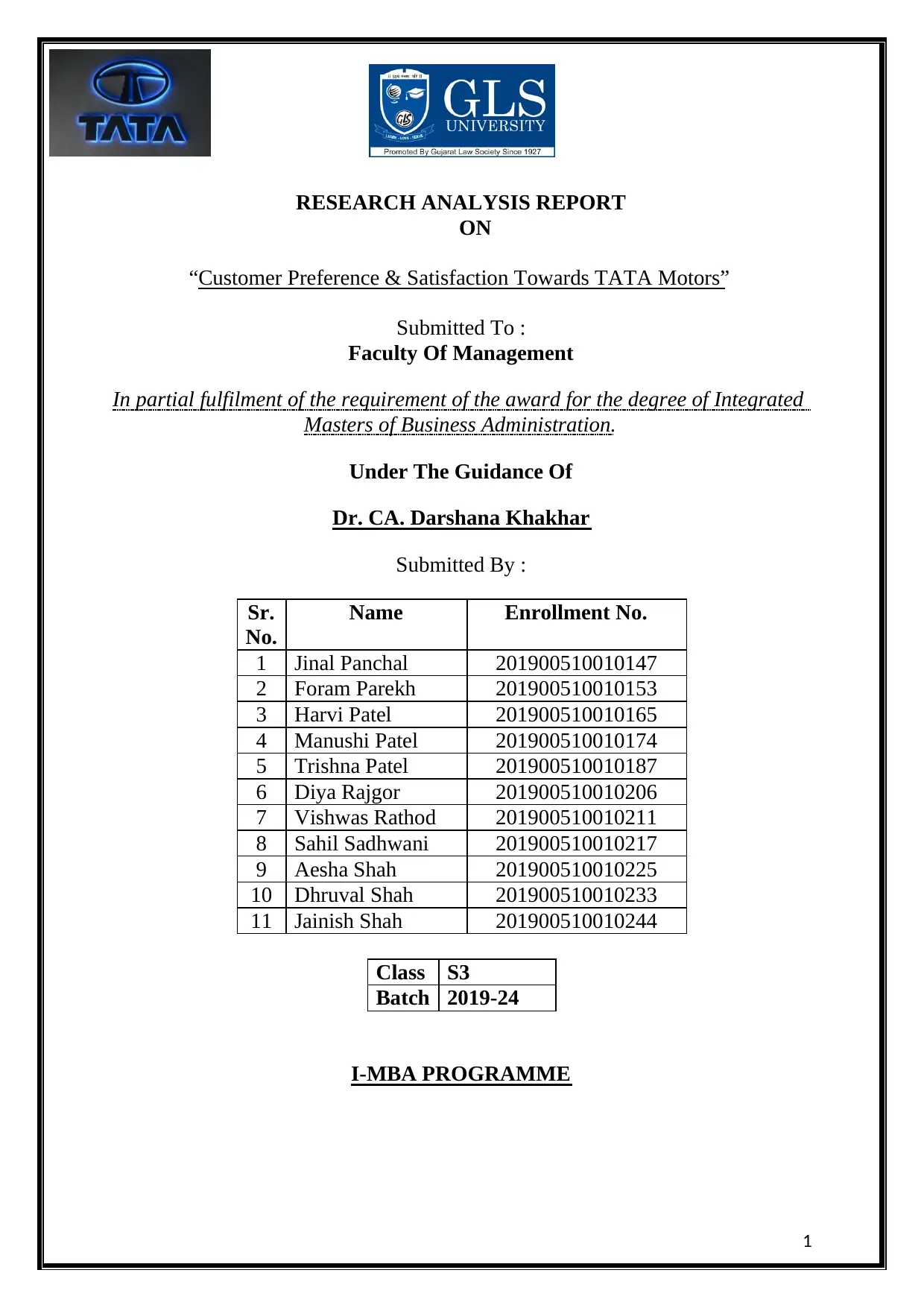
1
RESEARCH ANALYSIS REPORT
ON
“Customer Preference & Satisfaction Towards TATA Motors”
Submitted To :
Faculty Of Management
In partial fulfilment of the requirement of the award for the degree of Integrated
Masters of Business Administration.
Under The Guidance Of
Dr. CA. Darshana Khakhar
Submitted By :
Sr.
No.
Name Enrollment No.
1 Jinal Panchal 201900510010147
2 Foram Parekh 201900510010153
3 Harvi Patel 201900510010165
4 Manushi Patel 201900510010174
5 Trishna Patel 201900510010187
6 Diya Rajgor 201900510010206
7 Vishwas Rathod 201900510010211
8 Sahil Sadhwani 201900510010217
9 Aesha Shah 201900510010225
10 Dhruval Shah 201900510010233
11 Jainish Shah 201900510010244
Class S3
Batch 2019-24
I-MBA PROGRAMME
RESEARCH ANALYSIS REPORT
ON
“Customer Preference & Satisfaction Towards TATA Motors”
Submitted To :
Faculty Of Management
In partial fulfilment of the requirement of the award for the degree of Integrated
Masters of Business Administration.
Under The Guidance Of
Dr. CA. Darshana Khakhar
Submitted By :
Sr.
No.
Name Enrollment No.
1 Jinal Panchal 201900510010147
2 Foram Parekh 201900510010153
3 Harvi Patel 201900510010165
4 Manushi Patel 201900510010174
5 Trishna Patel 201900510010187
6 Diya Rajgor 201900510010206
7 Vishwas Rathod 201900510010211
8 Sahil Sadhwani 201900510010217
9 Aesha Shah 201900510010225
10 Dhruval Shah 201900510010233
11 Jainish Shah 201900510010244
Class S3
Batch 2019-24
I-MBA PROGRAMME
Paraphrase This Document
Need a fresh take? Get an instant paraphrase of this document with our AI Paraphraser
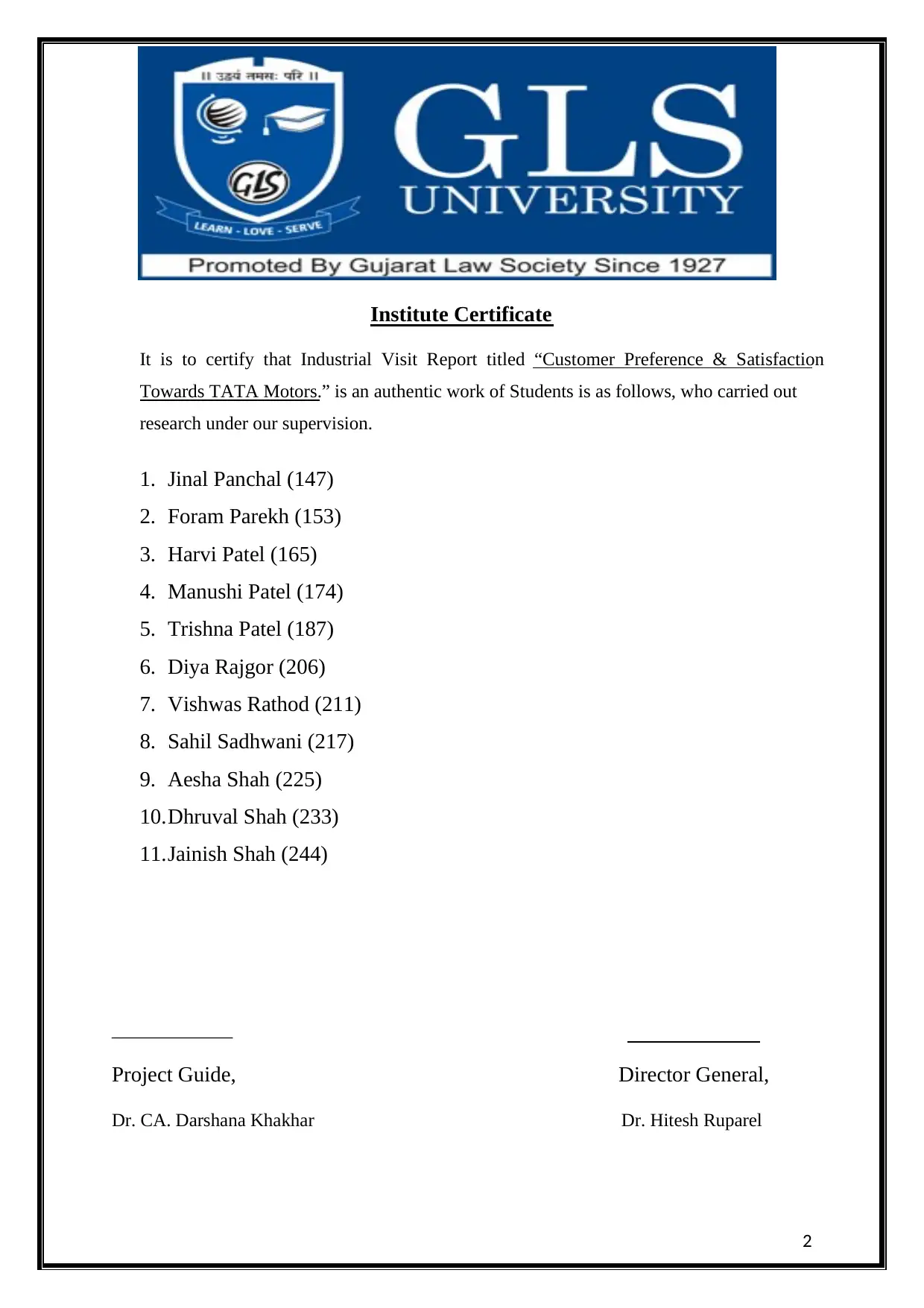
2
Institute Certificate
It is to certify that Industrial Visit Report titled “Customer Preference & Satisfaction
Towards TATA Motors.” is an authentic work of Students is as follows, who carried out
research under our supervision.
1. Jinal Panchal (147)
2. Foram Parekh (153)
3. Harvi Patel (165)
4. Manushi Patel (174)
5. Trishna Patel (187)
6. Diya Rajgor (206)
7. Vishwas Rathod (211)
8. Sahil Sadhwani (217)
9. Aesha Shah (225)
10. Dhruval Shah (233)
11. Jainish Shah (244)
_____________
Project Guide, Director General,
Dr. CA. Darshana Khakhar Dr. Hitesh Ruparel
Institute Certificate
It is to certify that Industrial Visit Report titled “Customer Preference & Satisfaction
Towards TATA Motors.” is an authentic work of Students is as follows, who carried out
research under our supervision.
1. Jinal Panchal (147)
2. Foram Parekh (153)
3. Harvi Patel (165)
4. Manushi Patel (174)
5. Trishna Patel (187)
6. Diya Rajgor (206)
7. Vishwas Rathod (211)
8. Sahil Sadhwani (217)
9. Aesha Shah (225)
10. Dhruval Shah (233)
11. Jainish Shah (244)
_____________
Project Guide, Director General,
Dr. CA. Darshana Khakhar Dr. Hitesh Ruparel
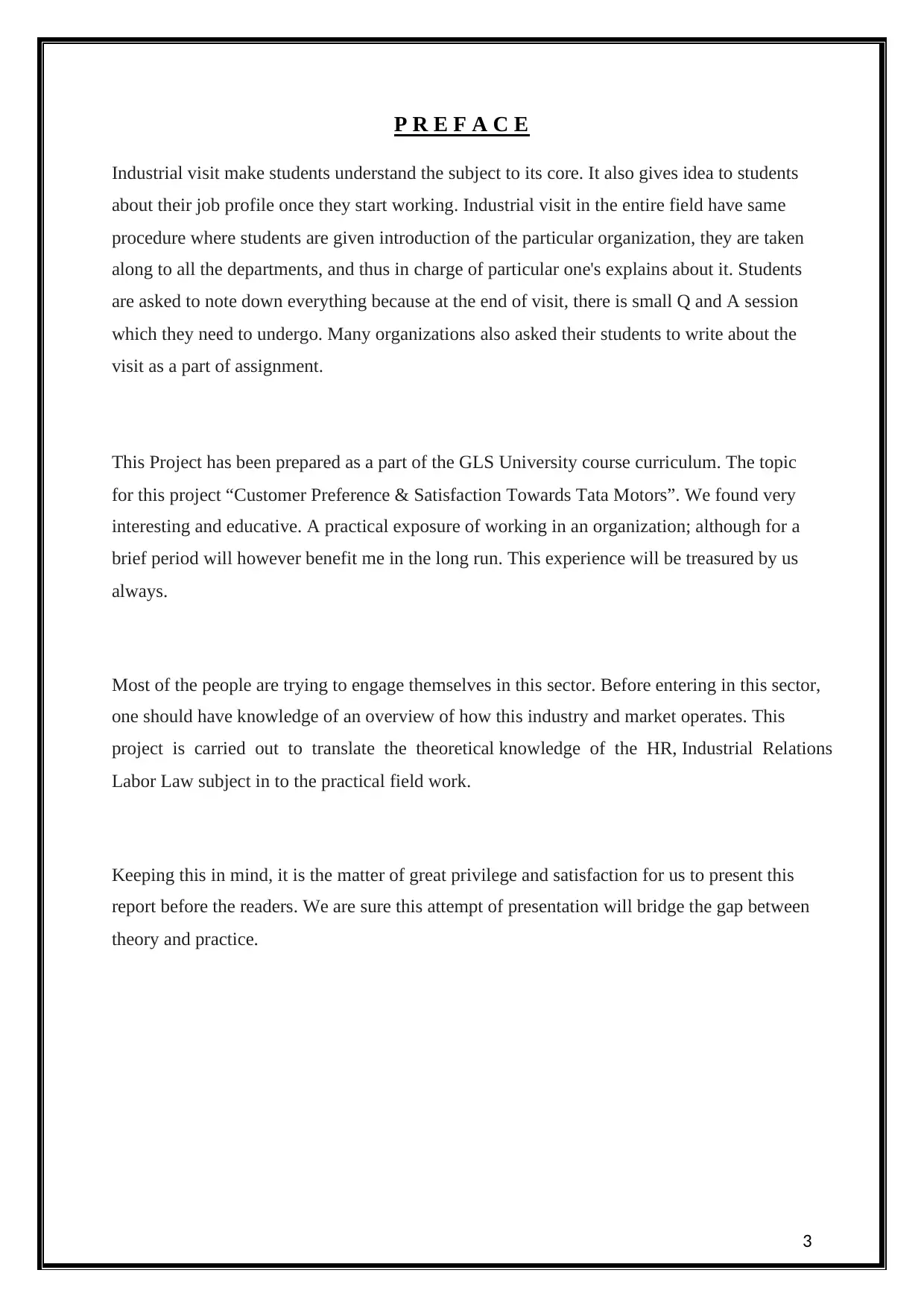
3
P R E F A C E
Industrial visit make students understand the subject to its core. It also gives idea to students
about their job profile once they start working. Industrial visit in the entire field have same
procedure where students are given introduction of the particular organization, they are taken
along to all the departments, and thus in charge of particular one's explains about it. Students
are asked to note down everything because at the end of visit, there is small Q and A session
which they need to undergo. Many organizations also asked their students to write about the
visit as a part of assignment.
This Project has been prepared as a part of the GLS University course curriculum. The topic
for this project “Customer Preference & Satisfaction Towards Tata Motors”. We found very
interesting and educative. A practical exposure of working in an organization; although for a
brief period will however benefit me in the long run. This experience will be treasured by us
always.
Most of the people are trying to engage themselves in this sector. Before entering in this sector,
one should have knowledge of an overview of how this industry and market operates. This
project is carried out to translate the theoretical knowledge of the HR, Industrial Relations
Labor Law subject in to the practical field work.
Keeping this in mind, it is the matter of great privilege and satisfaction for us to present this
report before the readers. We are sure this attempt of presentation will bridge the gap between
theory and practice.
P R E F A C E
Industrial visit make students understand the subject to its core. It also gives idea to students
about their job profile once they start working. Industrial visit in the entire field have same
procedure where students are given introduction of the particular organization, they are taken
along to all the departments, and thus in charge of particular one's explains about it. Students
are asked to note down everything because at the end of visit, there is small Q and A session
which they need to undergo. Many organizations also asked their students to write about the
visit as a part of assignment.
This Project has been prepared as a part of the GLS University course curriculum. The topic
for this project “Customer Preference & Satisfaction Towards Tata Motors”. We found very
interesting and educative. A practical exposure of working in an organization; although for a
brief period will however benefit me in the long run. This experience will be treasured by us
always.
Most of the people are trying to engage themselves in this sector. Before entering in this sector,
one should have knowledge of an overview of how this industry and market operates. This
project is carried out to translate the theoretical knowledge of the HR, Industrial Relations
Labor Law subject in to the practical field work.
Keeping this in mind, it is the matter of great privilege and satisfaction for us to present this
report before the readers. We are sure this attempt of presentation will bridge the gap between
theory and practice.
⊘ This is a preview!⊘
Do you want full access?
Subscribe today to unlock all pages.

Trusted by 1+ million students worldwide
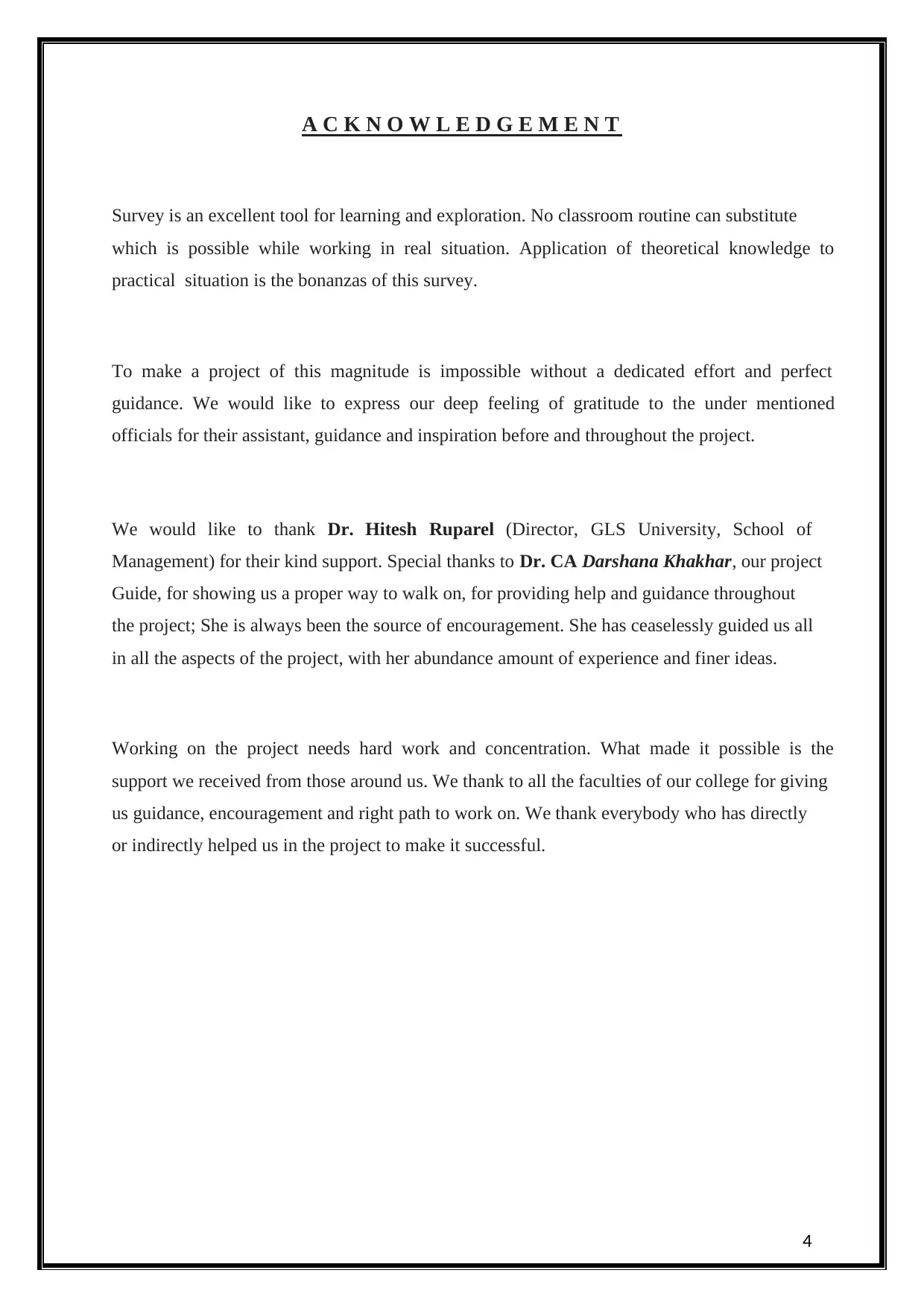
4
A C K N O W L E D G E M E N T
Survey is an excellent tool for learning and exploration. No classroom routine can substitute
which is possible while working in real situation. Application of theoretical knowledge to
practical situation is the bonanzas of this survey.
To make a project of this magnitude is impossible without a dedicated effort and perfect
guidance. We would like to express our deep feeling of gratitude to the under mentioned
officials for their assistant, guidance and inspiration before and throughout the project.
We would like to thank Dr. Hitesh Ruparel (Director, GLS University, School of
Management) for their kind support. Special thanks to Dr. CA Darshana Khakhar, our project
Guide, for showing us a proper way to walk on, for providing help and guidance throughout
the project; She is always been the source of encouragement. She has ceaselessly guided us all
in all the aspects of the project, with her abundance amount of experience and finer ideas.
Working on the project needs hard work and concentration. What made it possible is the
support we received from those around us. We thank to all the faculties of our college for giving
us guidance, encouragement and right path to work on. We thank everybody who has directly
or indirectly helped us in the project to make it successful.
A C K N O W L E D G E M E N T
Survey is an excellent tool for learning and exploration. No classroom routine can substitute
which is possible while working in real situation. Application of theoretical knowledge to
practical situation is the bonanzas of this survey.
To make a project of this magnitude is impossible without a dedicated effort and perfect
guidance. We would like to express our deep feeling of gratitude to the under mentioned
officials for their assistant, guidance and inspiration before and throughout the project.
We would like to thank Dr. Hitesh Ruparel (Director, GLS University, School of
Management) for their kind support. Special thanks to Dr. CA Darshana Khakhar, our project
Guide, for showing us a proper way to walk on, for providing help and guidance throughout
the project; She is always been the source of encouragement. She has ceaselessly guided us all
in all the aspects of the project, with her abundance amount of experience and finer ideas.
Working on the project needs hard work and concentration. What made it possible is the
support we received from those around us. We thank to all the faculties of our college for giving
us guidance, encouragement and right path to work on. We thank everybody who has directly
or indirectly helped us in the project to make it successful.
Paraphrase This Document
Need a fresh take? Get an instant paraphrase of this document with our AI Paraphraser
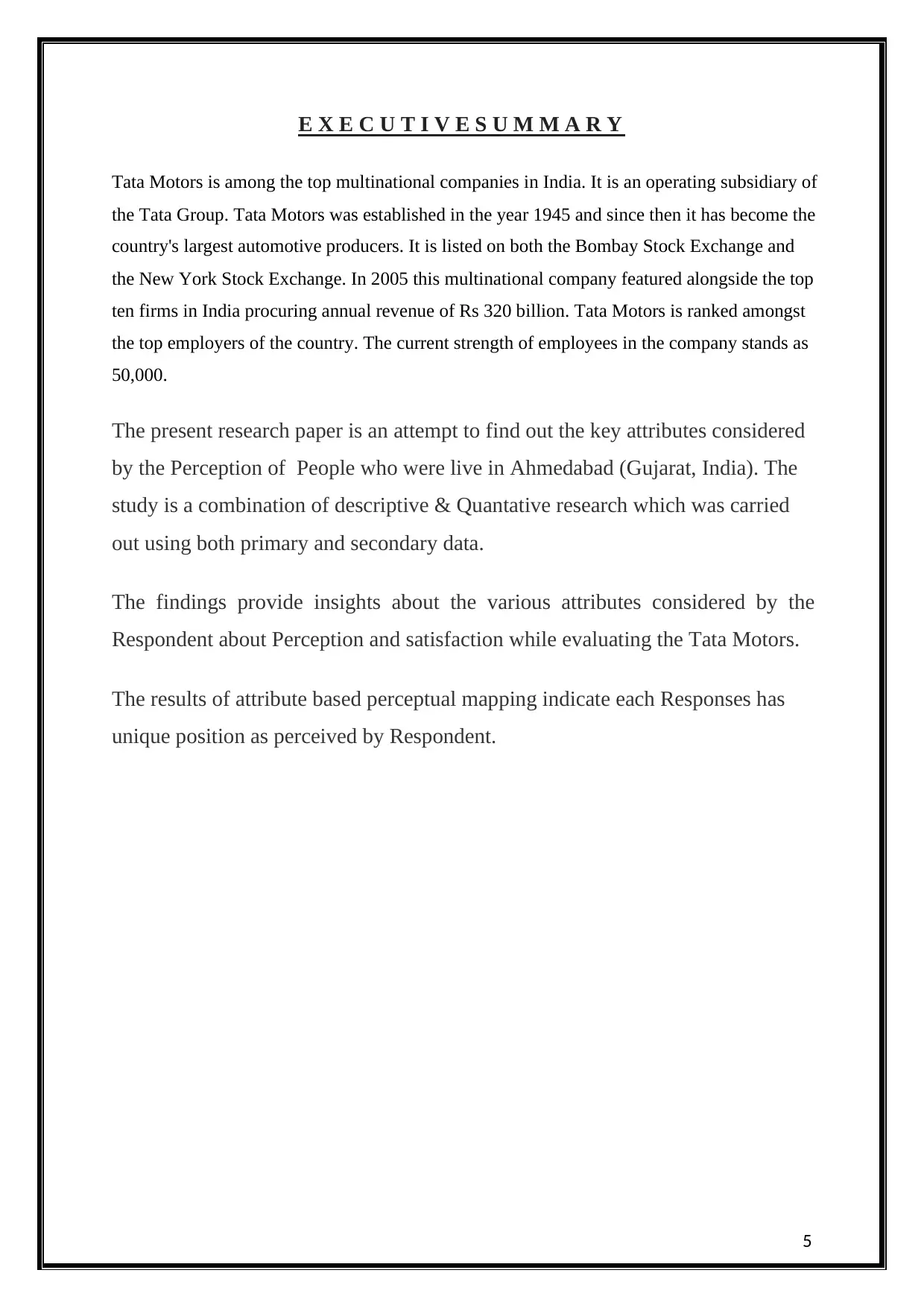
5
E X E C U T I V E S U M M A R Y
Tata Motors is among the top multinational companies in India. It is an operating subsidiary of
the Tata Group. Tata Motors was established in the year 1945 and since then it has become the
country's largest automotive producers. It is listed on both the Bombay Stock Exchange and
the New York Stock Exchange. In 2005 this multinational company featured alongside the top
ten firms in India procuring annual revenue of Rs 320 billion. Tata Motors is ranked amongst
the top employers of the country. The current strength of employees in the company stands as
50,000.
The present research paper is an attempt to find out the key attributes considered
by the Perception of People who were live in Ahmedabad (Gujarat, India). The
study is a combination of descriptive & Quantative research which was carried
out using both primary and secondary data.
The findings provide insights about the various attributes considered by the
Respondent about Perception and satisfaction while evaluating the Tata Motors.
The results of attribute based perceptual mapping indicate each Responses has
unique position as perceived by Respondent.
E X E C U T I V E S U M M A R Y
Tata Motors is among the top multinational companies in India. It is an operating subsidiary of
the Tata Group. Tata Motors was established in the year 1945 and since then it has become the
country's largest automotive producers. It is listed on both the Bombay Stock Exchange and
the New York Stock Exchange. In 2005 this multinational company featured alongside the top
ten firms in India procuring annual revenue of Rs 320 billion. Tata Motors is ranked amongst
the top employers of the country. The current strength of employees in the company stands as
50,000.
The present research paper is an attempt to find out the key attributes considered
by the Perception of People who were live in Ahmedabad (Gujarat, India). The
study is a combination of descriptive & Quantative research which was carried
out using both primary and secondary data.
The findings provide insights about the various attributes considered by the
Respondent about Perception and satisfaction while evaluating the Tata Motors.
The results of attribute based perceptual mapping indicate each Responses has
unique position as perceived by Respondent.
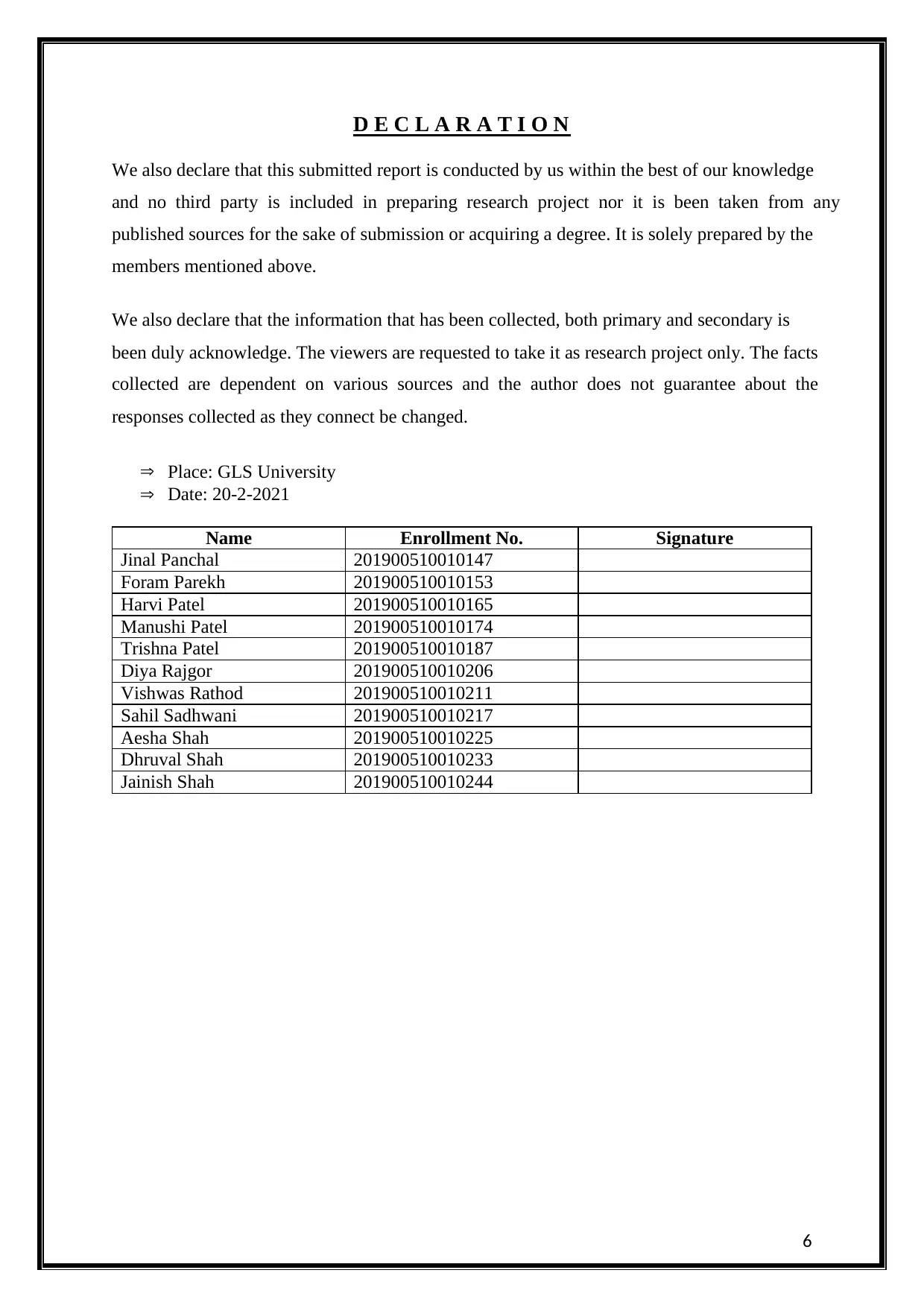
6
D E C L A R A T I O N
We also declare that this submitted report is conducted by us within the best of our knowledge
and no third party is included in preparing research project nor it is been taken from any
published sources for the sake of submission or acquiring a degree. It is solely prepared by the
members mentioned above.
We also declare that the information that has been collected, both primary and secondary is
been duly acknowledge. The viewers are requested to take it as research project only. The facts
collected are dependent on various sources and the author does not guarantee about the
responses collected as they connect be changed.
Þ Place: GLS University
Þ Date: 20-2-2021
Name Enrollment No. Signature
Jinal Panchal 201900510010147
Foram Parekh 201900510010153
Harvi Patel 201900510010165
Manushi Patel 201900510010174
Trishna Patel 201900510010187
Diya Rajgor 201900510010206
Vishwas Rathod 201900510010211
Sahil Sadhwani 201900510010217
Aesha Shah 201900510010225
Dhruval Shah 201900510010233
Jainish Shah 201900510010244
D E C L A R A T I O N
We also declare that this submitted report is conducted by us within the best of our knowledge
and no third party is included in preparing research project nor it is been taken from any
published sources for the sake of submission or acquiring a degree. It is solely prepared by the
members mentioned above.
We also declare that the information that has been collected, both primary and secondary is
been duly acknowledge. The viewers are requested to take it as research project only. The facts
collected are dependent on various sources and the author does not guarantee about the
responses collected as they connect be changed.
Þ Place: GLS University
Þ Date: 20-2-2021
Name Enrollment No. Signature
Jinal Panchal 201900510010147
Foram Parekh 201900510010153
Harvi Patel 201900510010165
Manushi Patel 201900510010174
Trishna Patel 201900510010187
Diya Rajgor 201900510010206
Vishwas Rathod 201900510010211
Sahil Sadhwani 201900510010217
Aesha Shah 201900510010225
Dhruval Shah 201900510010233
Jainish Shah 201900510010244
⊘ This is a preview!⊘
Do you want full access?
Subscribe today to unlock all pages.

Trusted by 1+ million students worldwide
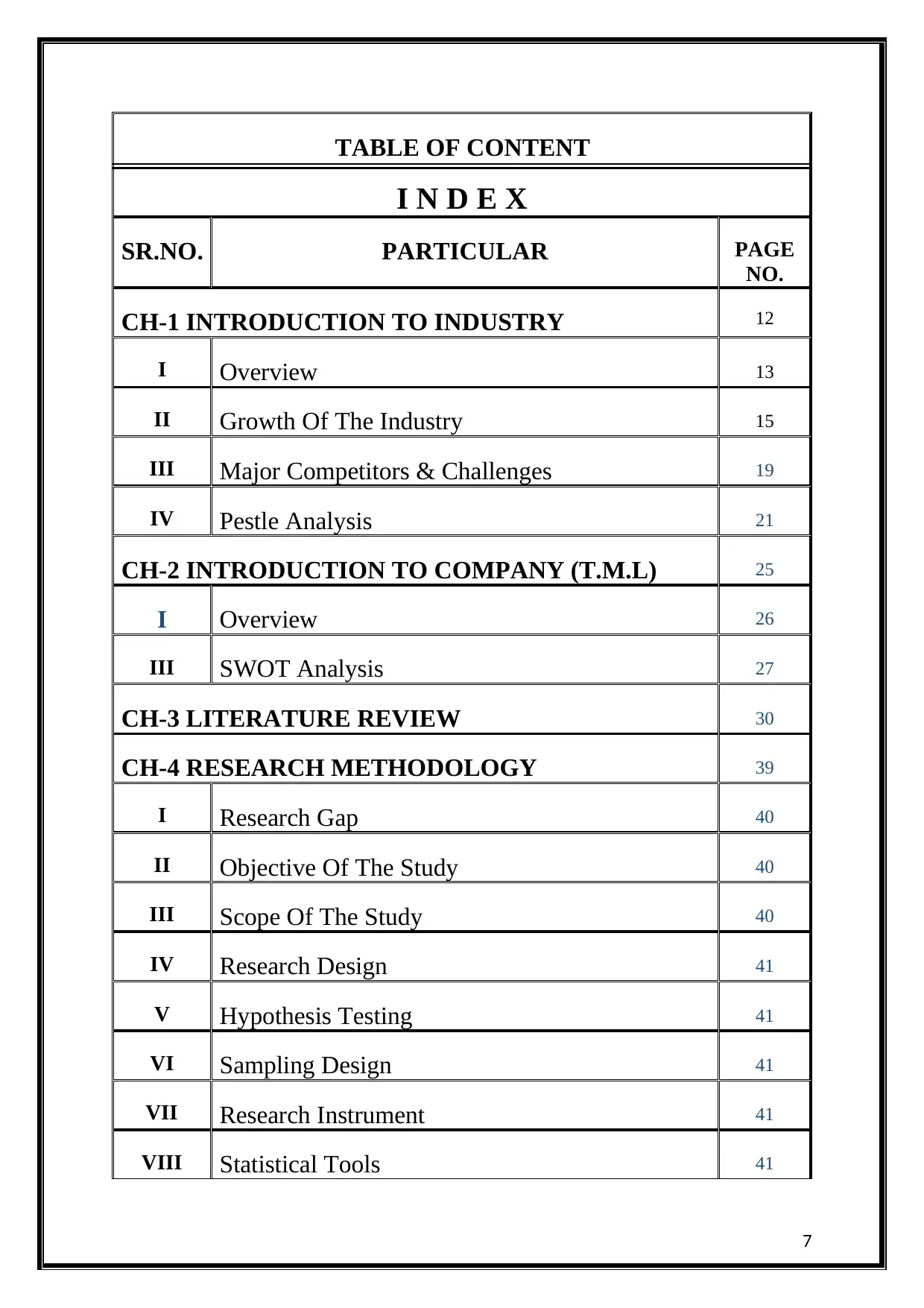
7
TABLE OF CONTENT
I N D E X
SR.NO. PARTICULAR PAGE
NO.
CH-1 INTRODUCTION TO INDUSTRY 12
I Overview 13
II Growth Of The Industry 15
III Major Competitors & Challenges 19
IV Pestle Analysis 21
CH-2 INTRODUCTION TO COMPANY (T.M.L) 25
I Overview 26
III SWOT Analysis 27
CH-3 LITERATURE REVIEW 30
CH-4 RESEARCH METHODOLOGY 39
I Research Gap 40
II Objective Of The Study 40
III Scope Of The Study 40
IV Research Design 41
V Hypothesis Testing 41
VI Sampling Design 41
VII Research Instrument 41
VIII Statistical Tools 41
TABLE OF CONTENT
I N D E X
SR.NO. PARTICULAR PAGE
NO.
CH-1 INTRODUCTION TO INDUSTRY 12
I Overview 13
II Growth Of The Industry 15
III Major Competitors & Challenges 19
IV Pestle Analysis 21
CH-2 INTRODUCTION TO COMPANY (T.M.L) 25
I Overview 26
III SWOT Analysis 27
CH-3 LITERATURE REVIEW 30
CH-4 RESEARCH METHODOLOGY 39
I Research Gap 40
II Objective Of The Study 40
III Scope Of The Study 40
IV Research Design 41
V Hypothesis Testing 41
VI Sampling Design 41
VII Research Instrument 41
VIII Statistical Tools 41
Paraphrase This Document
Need a fresh take? Get an instant paraphrase of this document with our AI Paraphraser
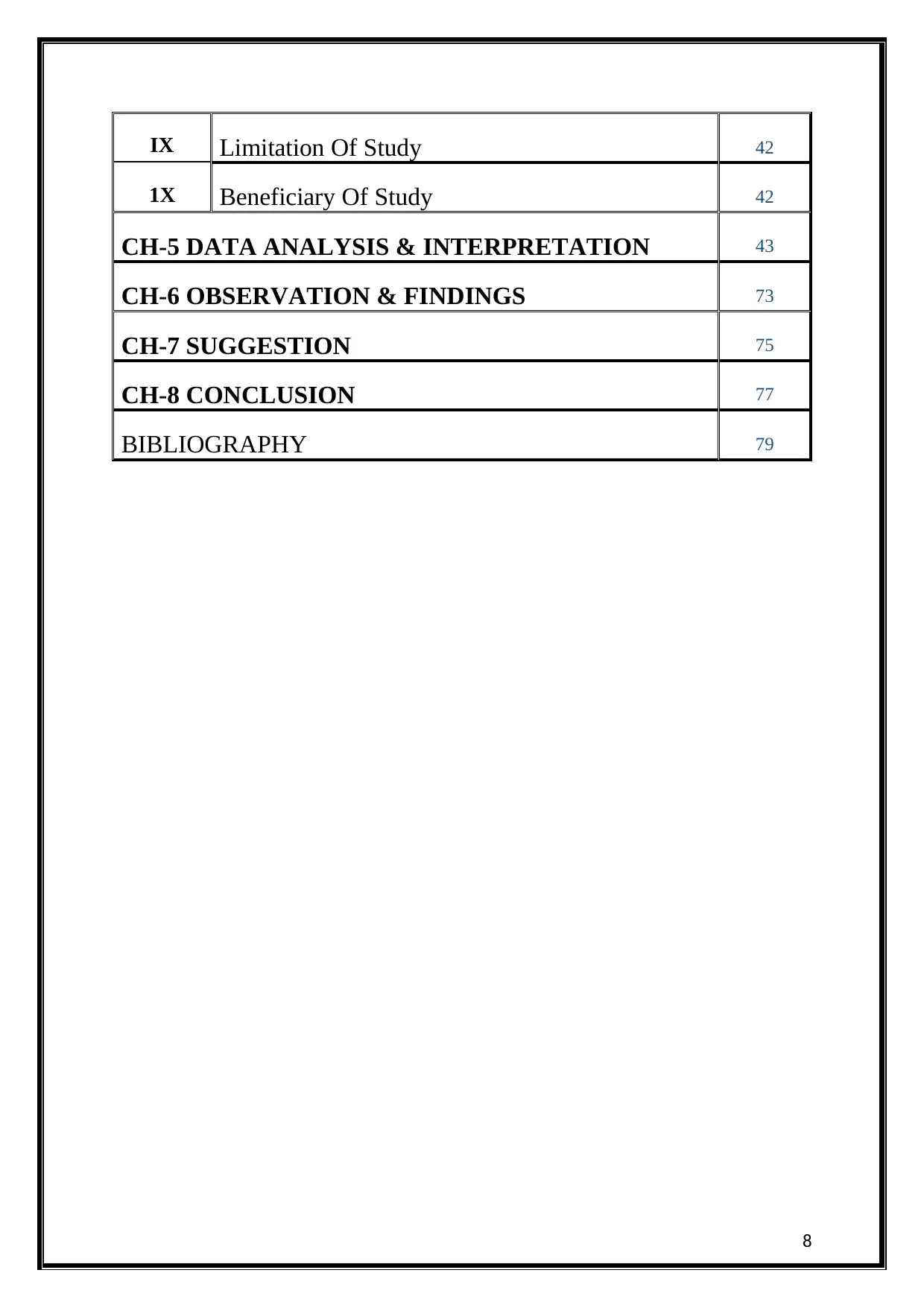
8
IX Limitation Of Study 42
1X Beneficiary Of Study 42
CH-5 DATA ANALYSIS & INTERPRETATION 43
CH-6 OBSERVATION & FINDINGS 73
CH-7 SUGGESTION 75
CH-8 CONCLUSION 77
BIBLIOGRAPHY 79
IX Limitation Of Study 42
1X Beneficiary Of Study 42
CH-5 DATA ANALYSIS & INTERPRETATION 43
CH-6 OBSERVATION & FINDINGS 73
CH-7 SUGGESTION 75
CH-8 CONCLUSION 77
BIBLIOGRAPHY 79
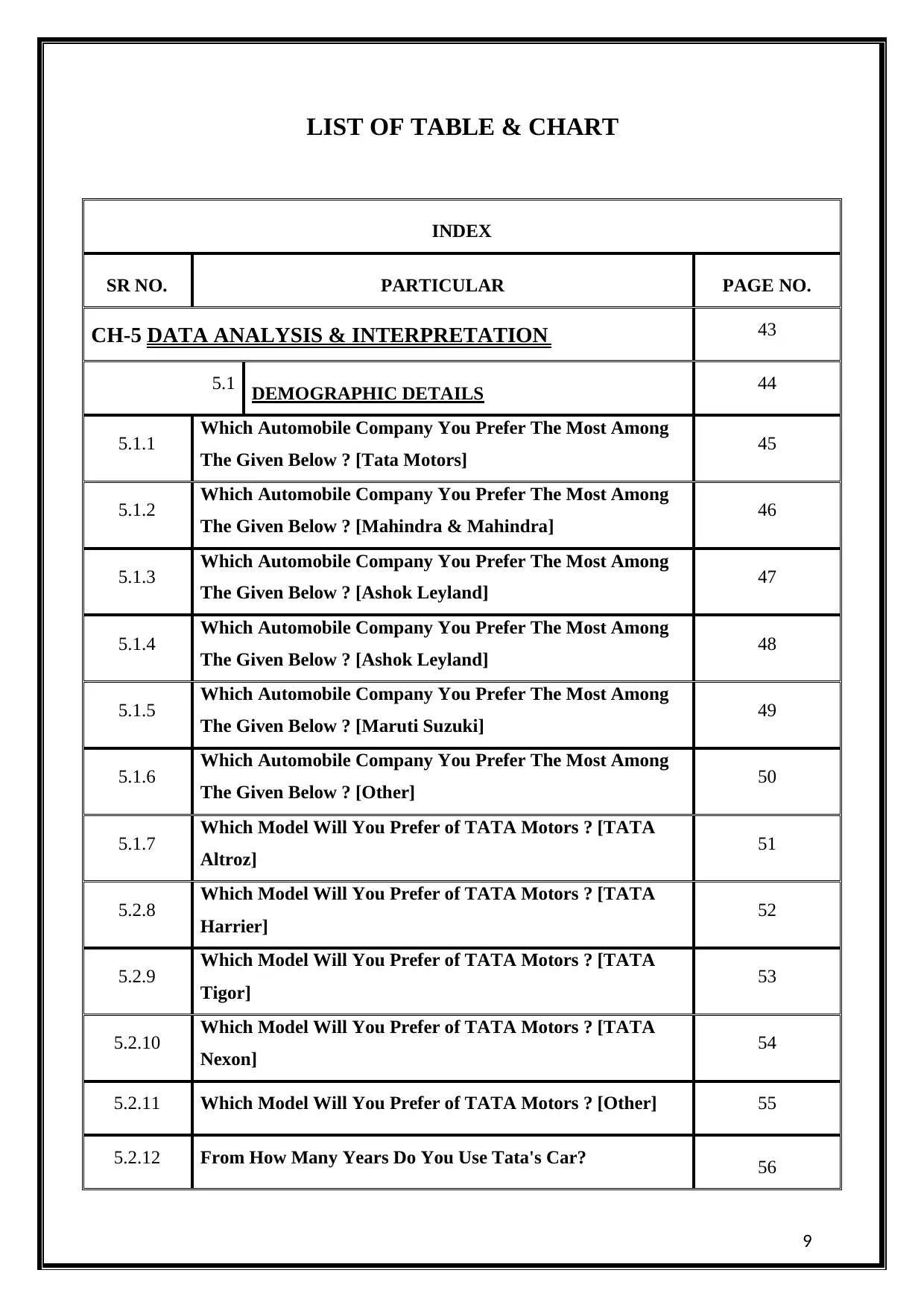
9
LIST OF TABLE & CHART
INDEX
SR NO. PARTICULAR PAGE NO.
CH-5 DATA ANALYSIS & INTERPRETATION 43
5.1 DEMOGRAPHIC DETAILS 44
5.1.1 Which Automobile Company You Prefer The Most Among
The Given Below ? [Tata Motors] 45
5.1.2 Which Automobile Company You Prefer The Most Among
The Given Below ? [Mahindra & Mahindra] 46
5.1.3 Which Automobile Company You Prefer The Most Among
The Given Below ? [Ashok Leyland] 47
5.1.4 Which Automobile Company You Prefer The Most Among
The Given Below ? [Ashok Leyland] 48
5.1.5 Which Automobile Company You Prefer The Most Among
The Given Below ? [Maruti Suzuki] 49
5.1.6 Which Automobile Company You Prefer The Most Among
The Given Below ? [Other] 50
5.1.7 Which Model Will You Prefer of TATA Motors ? [TATA
Altroz] 51
5.2.8 Which Model Will You Prefer of TATA Motors ? [TATA
Harrier] 52
5.2.9 Which Model Will You Prefer of TATA Motors ? [TATA
Tigor] 53
5.2.10 Which Model Will You Prefer of TATA Motors ? [TATA
Nexon] 54
5.2.11 Which Model Will You Prefer of TATA Motors ? [Other] 55
5.2.12 From How Many Years Do You Use Tata's Car? 56
LIST OF TABLE & CHART
INDEX
SR NO. PARTICULAR PAGE NO.
CH-5 DATA ANALYSIS & INTERPRETATION 43
5.1 DEMOGRAPHIC DETAILS 44
5.1.1 Which Automobile Company You Prefer The Most Among
The Given Below ? [Tata Motors] 45
5.1.2 Which Automobile Company You Prefer The Most Among
The Given Below ? [Mahindra & Mahindra] 46
5.1.3 Which Automobile Company You Prefer The Most Among
The Given Below ? [Ashok Leyland] 47
5.1.4 Which Automobile Company You Prefer The Most Among
The Given Below ? [Ashok Leyland] 48
5.1.5 Which Automobile Company You Prefer The Most Among
The Given Below ? [Maruti Suzuki] 49
5.1.6 Which Automobile Company You Prefer The Most Among
The Given Below ? [Other] 50
5.1.7 Which Model Will You Prefer of TATA Motors ? [TATA
Altroz] 51
5.2.8 Which Model Will You Prefer of TATA Motors ? [TATA
Harrier] 52
5.2.9 Which Model Will You Prefer of TATA Motors ? [TATA
Tigor] 53
5.2.10 Which Model Will You Prefer of TATA Motors ? [TATA
Nexon] 54
5.2.11 Which Model Will You Prefer of TATA Motors ? [Other] 55
5.2.12 From How Many Years Do You Use Tata's Car? 56
⊘ This is a preview!⊘
Do you want full access?
Subscribe today to unlock all pages.

Trusted by 1+ million students worldwide
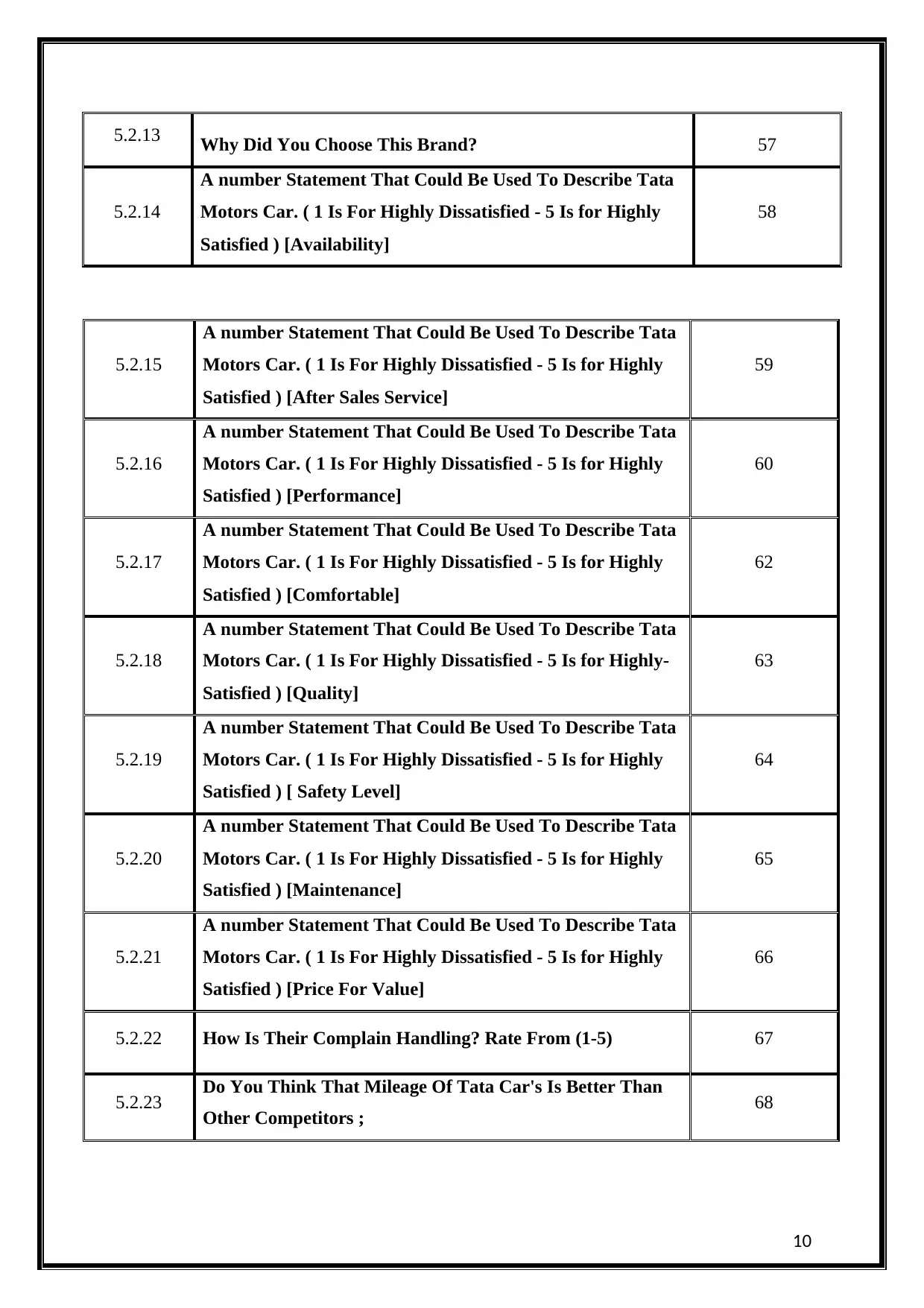
10
5.2.13 Why Did You Choose This Brand? 57
5.2.14
A number Statement That Could Be Used To Describe Tata
Motors Car. ( 1 Is For Highly Dissatisfied - 5 Is for Highly
Satisfied ) [Availability]
58
5.2.15
A number Statement That Could Be Used To Describe Tata
Motors Car. ( 1 Is For Highly Dissatisfied - 5 Is for Highly
Satisfied ) [After Sales Service]
59
5.2.16
A number Statement That Could Be Used To Describe Tata
Motors Car. ( 1 Is For Highly Dissatisfied - 5 Is for Highly
Satisfied ) [Performance]
60
5.2.17
A number Statement That Could Be Used To Describe Tata
Motors Car. ( 1 Is For Highly Dissatisfied - 5 Is for Highly
Satisfied ) [Comfortable]
62
5.2.18
A number Statement That Could Be Used To Describe Tata
Motors Car. ( 1 Is For Highly Dissatisfied - 5 Is for Highly-
Satisfied ) [Quality]
63
5.2.19
A number Statement That Could Be Used To Describe Tata
Motors Car. ( 1 Is For Highly Dissatisfied - 5 Is for Highly
Satisfied ) [ Safety Level]
64
5.2.20
A number Statement That Could Be Used To Describe Tata
Motors Car. ( 1 Is For Highly Dissatisfied - 5 Is for Highly
Satisfied ) [Maintenance]
65
5.2.21
A number Statement That Could Be Used To Describe Tata
Motors Car. ( 1 Is For Highly Dissatisfied - 5 Is for Highly
Satisfied ) [Price For Value]
66
5.2.22 How Is Their Complain Handling? Rate From (1-5) 67
5.2.23 Do You Think That Mileage Of Tata Car's Is Better Than
Other Competitors ; 68
5.2.13 Why Did You Choose This Brand? 57
5.2.14
A number Statement That Could Be Used To Describe Tata
Motors Car. ( 1 Is For Highly Dissatisfied - 5 Is for Highly
Satisfied ) [Availability]
58
5.2.15
A number Statement That Could Be Used To Describe Tata
Motors Car. ( 1 Is For Highly Dissatisfied - 5 Is for Highly
Satisfied ) [After Sales Service]
59
5.2.16
A number Statement That Could Be Used To Describe Tata
Motors Car. ( 1 Is For Highly Dissatisfied - 5 Is for Highly
Satisfied ) [Performance]
60
5.2.17
A number Statement That Could Be Used To Describe Tata
Motors Car. ( 1 Is For Highly Dissatisfied - 5 Is for Highly
Satisfied ) [Comfortable]
62
5.2.18
A number Statement That Could Be Used To Describe Tata
Motors Car. ( 1 Is For Highly Dissatisfied - 5 Is for Highly-
Satisfied ) [Quality]
63
5.2.19
A number Statement That Could Be Used To Describe Tata
Motors Car. ( 1 Is For Highly Dissatisfied - 5 Is for Highly
Satisfied ) [ Safety Level]
64
5.2.20
A number Statement That Could Be Used To Describe Tata
Motors Car. ( 1 Is For Highly Dissatisfied - 5 Is for Highly
Satisfied ) [Maintenance]
65
5.2.21
A number Statement That Could Be Used To Describe Tata
Motors Car. ( 1 Is For Highly Dissatisfied - 5 Is for Highly
Satisfied ) [Price For Value]
66
5.2.22 How Is Their Complain Handling? Rate From (1-5) 67
5.2.23 Do You Think That Mileage Of Tata Car's Is Better Than
Other Competitors ; 68
Paraphrase This Document
Need a fresh take? Get an instant paraphrase of this document with our AI Paraphraser

11
5.2.24 Do You Suggest Tata Motors Car To Someone Else? 69
5.2.25 What Is Your Overall Opinion About Tata Motors? 70
5.2.26 Gender 71
5.2.27 Age 72
5.2.28 Employment Status 73
5.2.29 Income 74
5.2.24 Do You Suggest Tata Motors Car To Someone Else? 69
5.2.25 What Is Your Overall Opinion About Tata Motors? 70
5.2.26 Gender 71
5.2.27 Age 72
5.2.28 Employment Status 73
5.2.29 Income 74
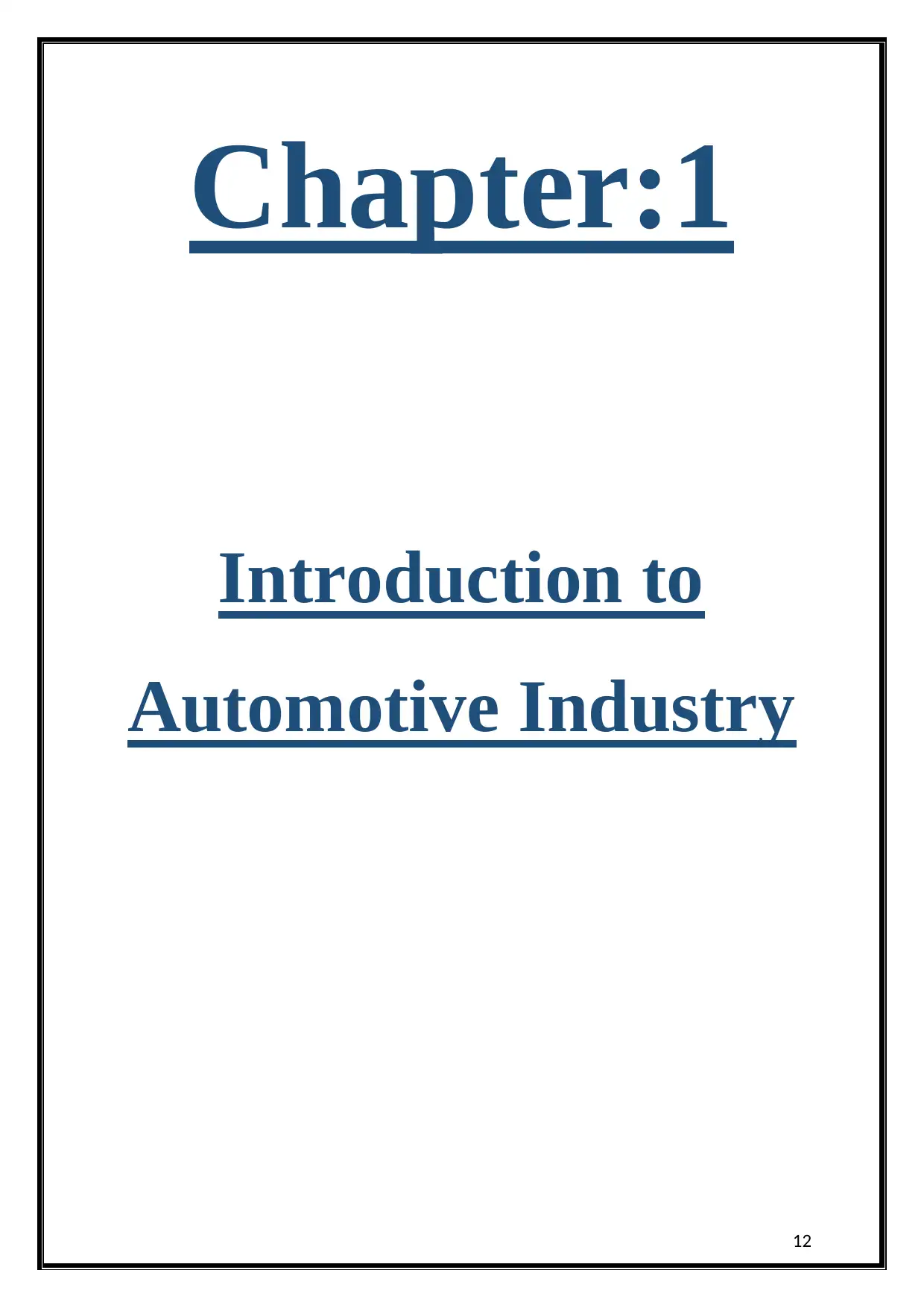
12
Chapter:1
Introduction to
Automotive Industry
Chapter:1
Introduction to
Automotive Industry
⊘ This is a preview!⊘
Do you want full access?
Subscribe today to unlock all pages.

Trusted by 1+ million students worldwide
1 out of 81
Your All-in-One AI-Powered Toolkit for Academic Success.
+13062052269
info@desklib.com
Available 24*7 on WhatsApp / Email
![[object Object]](/_next/static/media/star-bottom.7253800d.svg)
Unlock your academic potential
Copyright © 2020–2025 A2Z Services. All Rights Reserved. Developed and managed by ZUCOL.